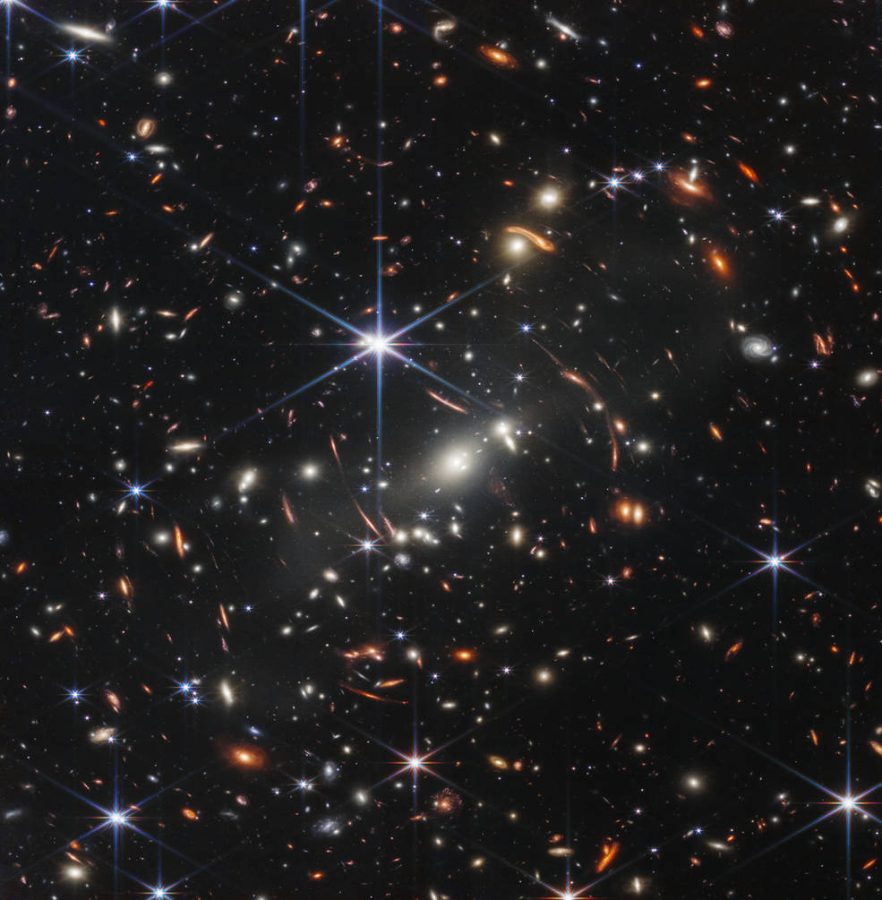Dallas College astronomers marvel new images of deep space
August 23, 2022
“It’s almost as if they don’t seem real.”
Eastfield alumnus Aldahir Segovia couldn’t believe his eyes after viewing the first images captured by the James Webb Space Telescope.
“I was blown away, especially when we compare them to past images,” Segovia said. “Just the quality – how crisp they look.”
In the same year Segovia continued his studies to become an astronomy professor, the James Webb Telescope released its first images of deep space on July 12.
The infrared telescope captured galaxy clusters and stars from record-breaking distances. The space telescope is currently NASA’s most powerful, having a higher view distance and quality than its predecessor, the Hubble Space Telescope.
SMACS 0723, the telescope’s flagship image, is the deepest infrared image of the universe. The photo features various galaxies from time frames close to the Big Bang.
“There’s a lot of things you can go into.” Segovia said. “There’s a difference between looking at something versus whenever you start to study it, finding more information that’s mind-blowing.”
Additionally, the James Webb Telescope captured detailed images of neighboring galaxies, nebulas and forming stars.
With an expected life of 20 years, astronomers expect a constant stream of groundbreaking images from the James Webb Telescope.
“I remember thinking, ‘oh my god, how can we get images that are better than the Hubble?’ The detail is amazing,” astronomy professor Heather Appleby said. “And then we get the James Webb and I’m saying the same thing over again.”
The images were internationally remarked by astronomers and reportedly brought NASA researchers to tears.
“As we really start digging into this data, we’re going to realize there’s more information than we can comprehend,” Appleby said. “I say that because the same thing happened with Hubble.”
One of the primary design choices for the James Webb Telescope was adopting an infrared light telescope, unlike its visible-light predecessor.
“People ask why it’s not a visible light telescope,” astronomy professor Christina Reeves-Shull said. “That’s because the farther back you go in time, the light has shifted towards red.”
A committee of NASA scientists proposed the James Webb Telescope in 1996 and developed the concept until 2002. Construction officially started in 2004 with a $1 billion budget.
A redesign in 2005, numerous delays and scheduling issues plagued the project. The budget jumped to $10 billion by its completion in 2016.
In 2011, the House of Representatives attempted canceling the project for its escalating budget and constant schedule delays, but Congress blocked the decision following public outcry.
The telescope launched in 2021 and became the first space telescope to position itself outside Earth’s orbit after several months of navigation.
“It’s a milestone for humans,” Segovia said. “We went from years of thinking about how to even capture these images to begin withto finally getting that evidence we’ve looked for.”
The James Webb Telescope produced its deepest image by focusing on a patch of space for an entire day. The Hubble Space Telescope produced a similar image in two weeks – with distinctly lesser clarity.
NASA gave the James Webb Telescope a 20-year life expectancy, but the Hubble Telescope’s service life cast doubt on that projection. It’s been in orbit for 32 years despite being initially expected to last 15 years.
The Hubble Telescope’s extended service life is owed to occasional repairs. On the contrary, the James Webb Telescope positions itself beyond reach for a better view of deep space.
“I think we’re really going to be amazed for the next 20 years,” Appleby said. “Our collective minds will be blown.”
Astronomers hope the James Webb Space Telescope continues producing new questions to ask about the universe.
“I think that’s how it going to be since human interest will never go away,” Segovia said. “We’re going to keep knowing what’s out there, especially because there’s the idea for space travel. This is the start for that.”




